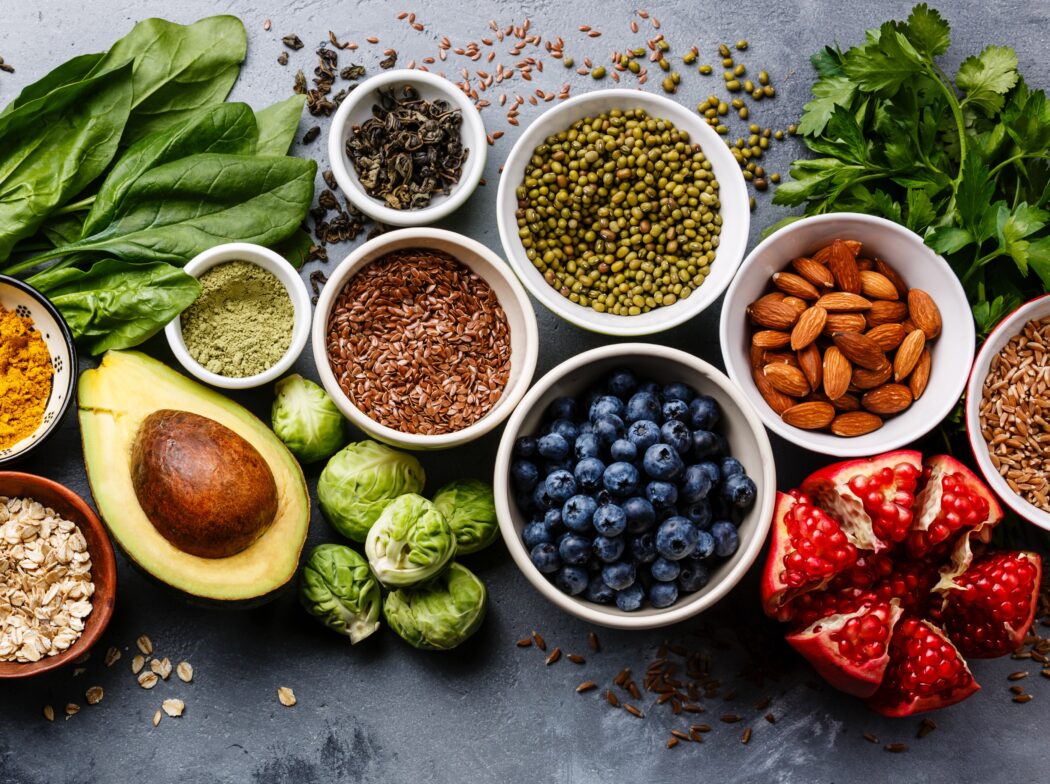The word ‘superfood’ is thrown all over the internet, from influencers on Instagram to health bloggers and vloggers— yet the true meaning behind the word is often unknown.
Nutritionally speaking, there is no such thing as a ‘superfood’. The term was coined for marketing purposes and the food industry puts the ‘superfood’ label on nutritious foods that have a capacity to affect health positively.
In the current state of the world, one of the best ways you can improve your overall health is to implement nutrition-rich foods into your everyday eating. Here are some of VALLEY’s suggestions of ‘superfoods’ as well as how and why they are important in your diet.
Leafy Greens
Dark green leafy greens are a great source of vitamin A, vitamin C and calcium, as well as fiber, folate, zinc and magnesium.
Some of their long term benefits are their potential to reduce the risk of chronic illnesses such as heart disease and type 2 diabetes, as well as potentially protecting from certain types of cancers due to the high levels of anti-inflammatory compounds in leafy greens, known as carotenoids.
Some common examples of dark leafy greens include kale, spinach, collard greens and turnip greens.
How to use them in your diet:
Dark leafy greens can be used in salads, soups, stews or enjoyed just by sautéing them in olive oil. Adding leafy greens in a smoothie or protein shake is also an easy way to get your greens in.
Nuts and Seeds
Nuts and seeds are a good source of plant-based protein, fiber and heart-healthy fats, in addition to having anti-inflammatory and antioxidant properties. These protect against oxidative stress; research has also shown that consuming nuts and seeds may also protect against heart disease.
Some common nuts include almonds, pecans, pistachios, walnuts, cashews, Brazil nuts and macadamia nuts. Sunflower seeds, pumpkin seeds, chia seeds, flaxseeds and hemp seeds are all examples of common seeds.
How to use them in your diet:
Nuts and seeds are super versatile in the ways you can implement them in your everyday diet. They are a great snack on their own, as well as a good topping on yogurt, salads, smoothies and oatmeal. Nut and seed butters are also a great option to try.
Berries
On top of being naturally sweet and delicious, berries are high in vitamins, minerals, fiber, antioxidants and other disease-fighting nutrients.
The antioxidants in berries are associated with a reduced risk of heart disease, cancer and other inflammatory conditions.
Some common berries include strawberries, blueberries, raspberries, blackberries and cranberries.
How to include them in your diet:
Berries are great in a variety of things. Freeze them and add them to smoothies or sprinkle them on top of such salads, yogurt or oatmeal bowls.
Legumes
A staple in any healthy diet: legumes. These superfood bonuses are a good way to toss a little extra fiber, folate, vitamin B and plant-based protein into your daily recipes.
Research has shown that legumes can help prevent as well as manage type 2 diabetes. They are also good for reducing blood pressure and cholesterol. A healthy amount of fiber in your diet is also necessary to maintain good gut health.
Kidney, black, red and garbanzo beans, as well as soybeans and peas are examples of legumes.
How to use them in your diet:
Legumes can be enjoyed in a variety of dishes including salads, soups, rice bowls and casseroles, as well as bean-based spreads such as hummus.
Ginger
You may be seeing ginger shots are all the rage right now; however, ginger originated in Southeast Asia and was commonly used to heal common ailments.
Ginger contains antioxidants, such as gingerol, that are associated with many health benefits such as reducing the risk of chronic illnesses such as heart disease, dementia and certain cancers. It also is used to manage nausea and reducing pain from acute and chronic inflammatory conditions.
How to use it in your diet:
Ginger juices and shots are common items you find at your local grocery store. However, if you are not quite ready to take a ginger shot, fresh ginger or even powdered forms can be used to spice up smoothies, teas, soups, sauces and stir-fries.
Avocado
While avocados are a fruit, it’s more often used as a vegetable in culinary applications. It is nutrition-rich in fiber, minerals, vitamins and healthy fats.
Avocado is rich in monounsaturated fats (MUFAs), which has been associated with reduced inflammation. Consuming avocados may also reduce the risk of heart disease, diabetes, metabolic syndrome and certain types of cancer.
How to use it in your diet:
Avocados can be used in a variety of different ways, such as in salads and rice bowls, or on toast or sandwiches. They can also be added to sauces and smoothies to create a creamy flavor.
Cruciferous vegetables
Cruciferous vegetables are full of fiber, vitamins, as well as phytochemicals including indoles, thiocyanates and nitriles— which have been associated with potentially reducing the risk of some types of cancer.
Some common cruciferous vegetables include brussels sprouts, broccoli, cauliflower, radishes and turnips.
How to use them in your diet:
While brussels sprouts and broccoli have earned a bad name from childhood movies and television shows, there are so many delicious ways to roast these veggies so that even the biggest haters will love them. You can also steam or sautéed cruciferous vegetables to add them to various dishes such as soups, salads, casseroles and pasta dishes.
Fish
Fish is a good source of protein, as well as omega-3 fatty acids, which can help prevent heart disease. Fish with the highest amount of omega-3 fatty acids include salmon, tuna steaks, mackerel, herring, trout, anchovies and sardines.
A drawback to eating salmon and other types of seafood is their possible continuation with environmental pollutants, such as heavy metals. This can be prevented by limiting your consumption of fish to two to three servings a week.
How to use it in your diet:
Frozen, fresh and canned fish can be prepared in a variety of ways and enjoyed in countess dishes.
Turmeric
Turmeric is a bright yellow spice which has origins in India and has long been used for its healing properties.
Curcumin, the active compound in turmeric, has high antioxidant and anti-inflammatory effects. Research has shown that curcumin may be effective in treating and preventing chronic diseases such as cancer, heart disease and diabetes, as well as aiding in pain reduction and wound healing.
How to use it in your diet:
While Turmeric supplements can also be an effective way of reaping the benefits of the spice, turmeric can also be used in teas, smoothies and soups. It should be paired with fats or other spices such as black pepper to help aid in its absorption.
At the end of the day…
There isn’t just one food or food group that is the key to good health. The best way to prevent potential disease and feel your best is to try to implement nutrient-rich foods into your everyday eating habits. Remember balance and consistency is key.





